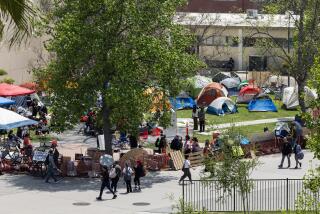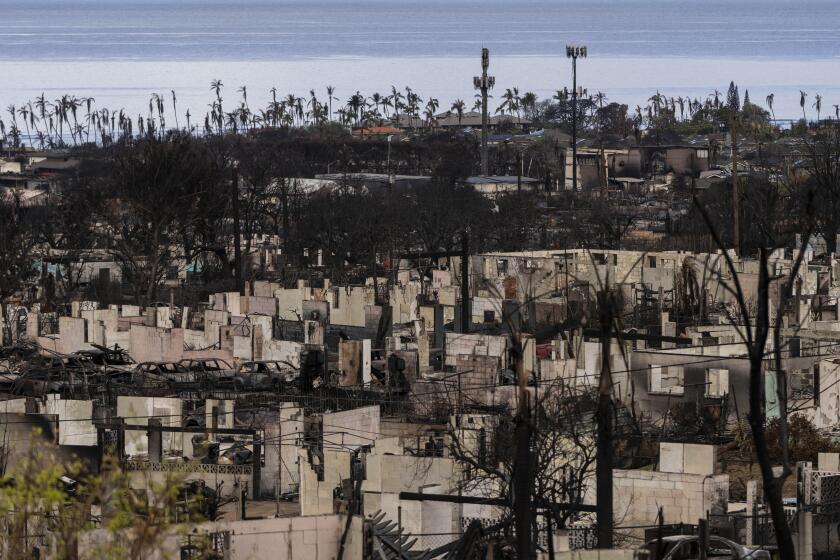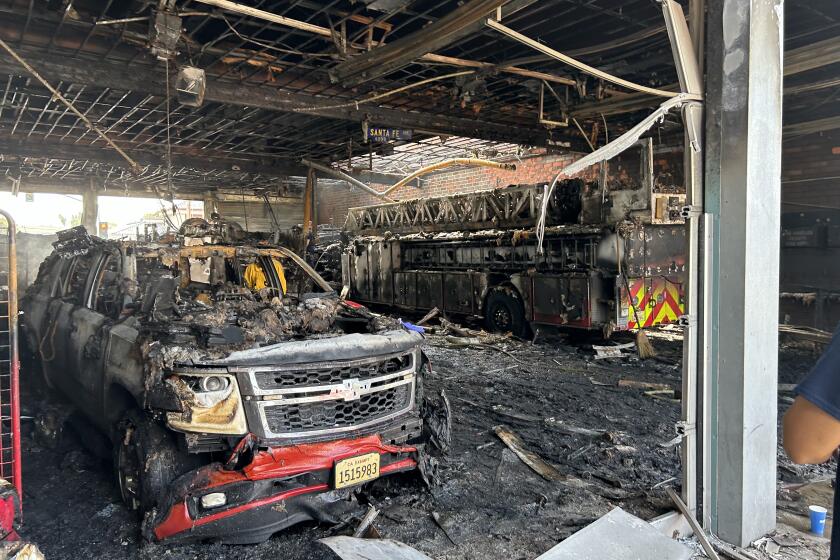Healing Process Is Far From Finished : Disaster: Signs of rebirth are mixed in with reminders of the blaze. But some residents have still not been able to rebuild.
Claire and Ted Lamb are luckier than most of those who lost their homes in Glendale’s worst fire one year ago today. They’re already back in a rebuilt house on Sweetbriar Drive.
Yet even now, 12 months later, the Lambs have not shaken off the trauma of watching their house, their furnishings and their treasured family mementos consumed by a furious, wind-driven blaze.
“I have nightmares all the time,” Claire Lamb said recently. “And every time I hear a siren, I run outside to see where it’s going off. I still envision all those flames and the house burning. It’s still so vivid in my mind, even after all this time.”
Though the embers cooled long ago, her husband is still nursing a grudge against Glendale Fire Chief John Montenero, charging that his department did a poor job of fighting the fire.
“I’m sure Montenero wishes it would go away, and I do, too,” Ted Lamb said. “But it won’t go away.”
The College Hills fire, named for the area where it began, left plenty of scars. It destroyed or damaged 64 houses and caused about $19 million in damage, according to fire officials.
Although no one was killed or seriously injured, the fire inflicted great financial and emotional damage on residents who lost their houses. A year has passed, but the healing process is far from finished.
The fire occurred on an unusually windy summer day when the mercury had soared above 100 degrees. A still-unknown arsonist ignited a hillside just south of Glendale College. The fast-moving flames jumped across rooftops and devoured dry brush to move from one cluster of houses to the next.
Today, charred vegetation, a few piles of rubble and twisted bits of yellow police tape are the most visible reminders in the three neighborhoods scorched by last year’s fire.
But there are also signs of rebirth. Construction hammers are pounding at a steady pace, and many lots that were still marred by debris at Christmas have been cleared.
A recent Times drive-by survey of the 45 most seriously damaged houses found that 13 had been rebuilt or were near completion. Another 11 were under construction. On 21 other lots, no construction activity was apparent.
In interviews, some owners of the lots where no rebuilding has begun said they have been delayed by insurance negotiations, design changes and city reviews. Many said they expect to begin reconstruction soon.
“I didn’t think it would take this long,” said Linda Knutson, a sheriff’s deputy who lost her home on Gladys Drive. “But, then again, I’ve never been through this before.”
Knutson and her husband, Edward, have about two-thirds of the funds they need to rebuild. They hope to start by the end of the summer. “We were terribly under-insured,” Knutson said, echoing the most common lament among the Glendale fire victims.
About $4 million of the fire’s losses were not covered by insurance, Glendale officials estimated in October. The Lambs, the Knutsons and many other fire victims had to draw from their savings or apply for low-interest government loans to rebuild and refurnish their houses.
Although their house has been rebuilt, the Lambs have left several rooms empty because of the strain on their finances. “All the furnishings cost three or four times as much as they did years ago,” Claire Lamb said.
Homeowners who did not increase their damage coverage in recent years must shoulder part of the blame themselves, said Mike Harris, a spokesman for California Fair Plan.
Fair Plan is a joint venture of property insurance companies that covers residents in high-risk areas, including Glendale’s hillside neighborhoods. After the College Hills fire, Fair Plan paid $4.9 million to owners of 17 houses that were destroyed and 24 houses that were damaged.
“Most of those people had been in their houses for a number of years,” Harris said. “As most people do, they just tend to renew it as-is every year, even though the property values were continuing to go up.”
Kevin and Adriana Smith were among the most under-insured of the fire victims. The Smiths, both surgical nurses at Childrens Hospital in Los Angeles, spent several months last year sprucing up an older house on Glenmore Boulevard, then bought it for $200,000 from Kevin Smith’s family in a private land transfer.
Less than two months later, before they had updated the insurance coverage, the house was destroyed. The Smiths were still responsible for about $180,000 in payments on the destroyed house and had to raise another $250,000 to build a new one. Until they can rebuild, they must also rent an apartment for themselves and daughter Elissa, 2.
The Smiths’ outdated insurance policy provided just $60,000 for the house and $15,000 for the contents. “It would probably be enough to build a garage,” said Kevin Smith, 28.
Because of the enormous debts, “we work day and night,” said Adriana Smith, 33. The Smiths’ co-workers chipped in $5,000 so they could clear the rubble from their lot.
The couple are taking advantage of government aid programs. The Federal Emergency Management Agency is covering most of their rental expenses. The federal Small Business Administration has approved a $120,000 loan at 4% interest.
The Smiths are also seeking another $100,000 from the California Natural Disaster Assistance Program. CALDAP is a last-resort agency that helps disaster victims who have exhausted all insurance benefits and federal aid. It provides low-interest loans that need not be paid back until the owners relocate, sell the property or refinance their other debts.
Six Glendale fire victims have applied for $445,000 in CALDAP loans. Two have been approved and the others are awaiting final review, said Michael Carroll, senior program manager for CALDAP.
The paperwork required for these aid programs and the rebuilding plans has been overwhelming, Kevin Smith said. “It’s like an eight-track tape--it never ends.”
Even some residents who did not lose their houses in the fire have been hurt.
When the smoke cleared on Avonoak Terrace a year ago, Raymond J. Martin’s residence was dubbed “the miracle house.” Four neighboring houses had been destroyed, but Martin’s received relatively little damage. He credited his fire-resistant metal roof and lack of flammable landscaping near the house.
Today, only one of his neighbors has begun to rebuild. Before the fire, Martin had been planning to sell his house and move to Santa Monica. Because of the burned lots that still surround him, he has put that plan on hold.
“I was told by a real estate agent that until these lots are rebuilt, my property value is down 18% to 20%,” said Martin, a retired businessman. “Who’d buy it now?”
Fire officials have spent much of the past year pursuing programs that could avert another College Hills-type disaster.
Montenero remains firmly in command despite a call for his ouster in November by residents who were angry about their losses.
Montenero believes that hillside residents must accept some of the responsibility for fire protection. At his urging, the City Council approved a mandatory brush clearance ordinance affecting 3,200 structures. It requires property owners to trim or remove vegetation that could fuel a fire and ignite an adjacent building.
Since inspections began in February, 1,500 clearance orders have been issued. “We’ve had over a 90% voluntary compliance rate,” Fire Marshal Chris Gray said.
Montenero said this measure should give homeowners a greater safety margin than they had in the College Hills fire. “We’re working hard to see that we have more defensible space between the brush and the homes,” he said.
Yet he pointed out that March rains have brought wild vegetation back to life. Homeowners will be in danger as long as they live close to plants that could catch fire, he said. “The brush is still as dangerous as last year,” Montenero said. “And maybe even more so.”
He added that scenic neighborhoods will also remain unsafe as long as some residents retain their flammable wood roofs.
Assistant Fire Chief Richard Hinz said this was a key factor in the College Hills blaze. “That was not a major brush fire,” Hinz said. “The real spreading was roof to roof.”
Councilman Carl Raggio, whose son lost a house in the fire, said last week that he has not abandoned his plan to force residents to replace wood roofs. Fire officials have backed the idea, but a majority of council members rejected it, saying it would force homeowners to spend thousands of dollars to comply.
Raggio said he will introduce the plan again in the future.
Such City Hall debates seem to have made little impression on the fire victims. They have directed most of their energy toward rebuilding their lives.
Amelia Reinhart, a longtime civic activist, has been tending her roses and fruit trees on a small ranch in Agua Dulce, waiting for reconstruction to begin on her Sweetbriar Drive house, a few doors from the Lambs.
Reinhart, 88, was hit especially hard by the fire because it occurred shortly after the death of her husband.
“I do have difficulty, and I do get depressed when I think of all that’s gone on over the past two years,” she said. “But life must go on and I try to be philosophical about it. I’m sure the good Lord doesn’t want us to succumb to our problems. We must fight back and keep on going. Like the old saying goes: ‘Pick yourself up, dust yourself off and keep on going.’ ”
State and Federal Aid to Fire Victims
* Individual and Family Grants: This federal program, administered by the state, provided 13 grants to Glendale fire victims totaling $184,132. Funds were used to replace lost necessities such as clothing, eyeglasses and dentures.
* Federal Emergency Management Agency: This agency paid $82,966 to 10 Glendale fire victims for temporary housing expenses. This aid was provided to those whose insurance did not cover temporary housing.
* Small Business Administration: This federal agency provided 23 Glendale fire victims with $1.8 million in loans. Nineteen of the loans were at 4% interest, four at 8%. Loans are for up to 30 years. The loans were up to $100,000 per family to rebuild and up to $20,000 to replace personal property.
* California Natural Disaster Assistance Program: This state program is a last resort for disaster victims who have exhausted insurance benefits and federal aid. It has approved two loans to Glendale fire victims totaling $115,000. Four other applications requesting another $340,000 are awaiting final approval. These loans are at 3% simple interest and need not be repaid until the owner sells the house, moves elsewhere or refinances other debts.
Reconstruction: One Year After the Fire
45 houses suffered 30% or more damage in the fire, which occured June 27, 1990. Chart shows what has become of those properties today.
No construction activity: 47% (21)
House rebuilt or near completion: 29% (13)
Reconstruction is under way: 24% (11)
More to Read
Start your day right
Sign up for Essential California for news, features and recommendations from the L.A. Times and beyond in your inbox six days a week.
You may occasionally receive promotional content from the Los Angeles Times.






